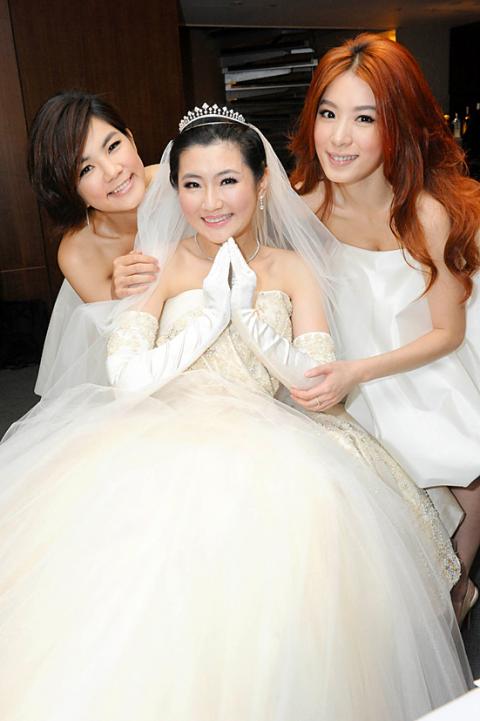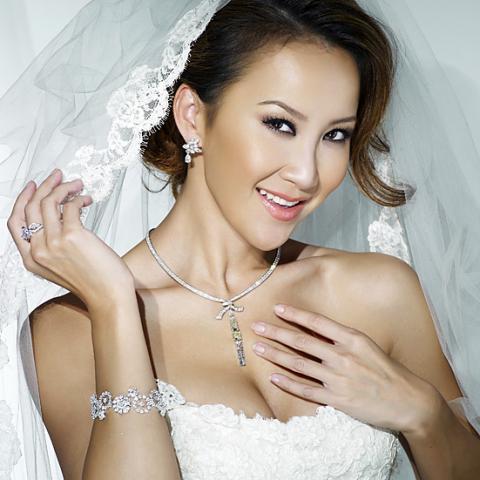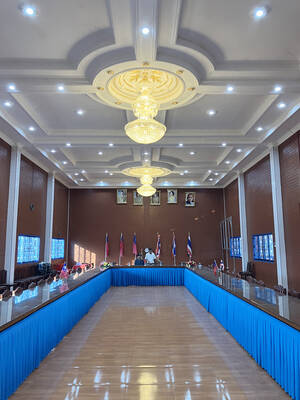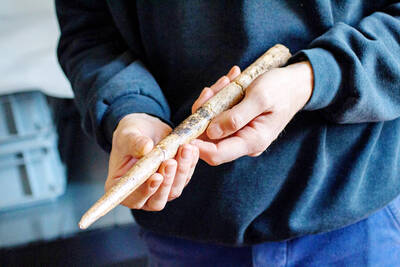As 2011 draws to a close, celebrities have made this the year of the showbiz wedding.
Over the past 10 months, a slew of A-listers, including self-styled actress Barbie Hsu (徐熙媛, aka Big S), TV sweetheart Patty Hou (侯佩岑), star couple Christine Fan (范瑋琪) and Charles Chen (陳建州, better known as Blackie), singer Stephanie Sun (孫燕姿) and belle Kelly Lin (林熙蕾) have tied the knot.
The nuptials that received top media billing were those of pop singer Selina Jen (任家萱), who wed 39-year-old lawyer Richard Chang (張承中).

Photo: Taipei Times
Following a year of medical treatment for serious burns she sustained while filming a TV show in China in October last year, Jen, a member of girl band S.H.E, was married on her 30th birthday, on Monday.
The event, full of warm, touching moments as the teary-eyed bride received blessings from friends and relatives, attracted more than 200 members of the media.
Because of her injuries, Jen sat through most of the three-hour-long wedding reception. The Apple Daily reported that the star underwent eight hours of rehabilitation each day since suffering multiple third-degree burns and cannot stand for longer than five minutes without taking a break.

Photo: Taipei Times
Not ones to let romance go to their heads, gossip hounds spent the evening sniffing out awkward moments between celebrity guests who are erstwhile lovers or old rivals.
Attention focused on pop diva Chang Hui-mei’s (張惠妹, better known as A-mei, 阿妹) old flame Wang Lee-hom (王力宏) and rumored new love Harlem Yu (庾澄慶). Much to the dismay of members of paparazzi, Wang and Chang were seen conversing over drinks amicably.
“We are good friends,” Wang told reporters.
Things were less peaceful between Jolin Tsai (蔡依林) and Patty Hou, who reportedly stole Jay Chou (周杰倫) from Tsai in 2004. In response to years-old rumors of a feud between her and Tsai, the married Hou claimed she often bumped into Tsai at the airport, and they always greet each other.
“Did I do that?” Tsai replied when asked to comment on Hou’s remark.
Meanwhile, in Hong Kong, international star Coco Lee (李玟) became the subject of admiration and envy when she wed 52-year-old Canadian businessman Bruce Rockowitz in a lavish ceremony on Thursday last week.
In terms of sumptuousness, Lee and Rockowitz’s nuptials lead the field, with two days of celebrations that reportedly cost NT$600 million. The wedding was rated by the press as the most expensive to be held in Hong Kong.
Readers might wonder how hundreds of millions of NT dollars could be spent in just two days, but with more than 300 guests flying in from the four corners of the world to attend the ceremony and stay at the Ritz-Carlton hotel, all courtesy of the newly weds, it’s not such a surprise.
Entertainment was provided by Grammy-winning musicians Bruno Mars, Alicia Keys and Ne-Yo, while the Shaw Brothers Film Studio, which, according to the Liberty Times (the Taipei Times’ sister paper), is normally not allowed to be rented out for private use, was turned into a playground for the rich and powerful.
Guests who graced the event included fashion designer Tommy Hilfiger and Christopher Patten, the last governor of Hong Kong.
Jennifer Lopez, Oprah Winfrey and Beyonce, however, didn’t show up as previously promised.

Taiwan Power Co (Taipower, 台電) and the New Taipei City Government in May last year agreed to allow the activation of a spent fuel storage facility for the Jinshan Nuclear Power Plant in Shihmen District (石門). The deal ended eleven years of legal wrangling. According to the Taipower announcement, the city government engaged in repeated delays, failing to approve water and soil conservation plans. Taipower said at the time that plans for another dry storage facility for the Guosheng Nuclear Power Plant in New Taipei City’s Wanli District (萬里) remained stuck in legal limbo. Later that year an agreement was reached

What does the Taiwan People’s Party (TPP) in the Huang Kuo-chang (黃國昌) era stand for? What sets it apart from their allies, the Chinese Nationalist Party (KMT)? With some shifts in tone and emphasis, the KMT’s stances have not changed significantly since the late 2000s and the era of former president Ma Ying-jeou (馬英九). The Democratic Progressive Party’s (DPP) current platform formed in the mid-2010s under the guidance of Tsai Ing-wen (蔡英文), and current President William Lai (賴清德) campaigned on continuity. Though their ideological stances may be a bit stale, they have the advantage of being broadly understood by the voters.

In a high-rise office building in Taipei’s government district, the primary agency for maintaining links to Thailand’s 108 Yunnan villages — which are home to a population of around 200,000 descendants of the Chinese Nationalist Party (KMT) armies stranded in Thailand following the Chinese Civil War — is the Overseas Community Affairs Council (OCAC). Established in China in 1926, the OCAC was born of a mandate to support Chinese education, culture and economic development in far flung Chinese diaspora communities, which, especially in southeast Asia, had underwritten the military insurgencies against the Qing Dynasty that led to the founding of

Artifacts found at archeological sites in France and Spain along the Bay of Biscay shoreline show that humans have been crafting tools from whale bones since more than 20,000 years ago, illustrating anew the resourcefulness of prehistoric people. The tools, primarily hunting implements such as projectile points, were fashioned from the bones of at least five species of large whales, the researchers said. Bones from sperm whales were the most abundant, followed by fin whales, gray whales, right or bowhead whales — two species indistinguishable with the analytical method used in the study — and blue whales. With seafaring capabilities by humans